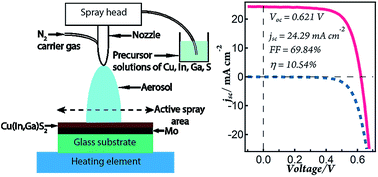Synthesis of Cu(In,Ga)(S,Se)2 thin films using an aqueous spray-pyrolysis approach, and their solar cell efficiency of 10.5%†
Abstract
Semiconducting Cu(In,Ga)(S,Se)2 (CIGSSe) thin-film is prepared by the spray-pyrolysis of aqueous precursor solutions of copper (CuCl2), indium (InCl3), gallium (GaCl3), and sulphur (SC(NH2)2) sources. The non-vacuum approach of making the CIGSSe thin film using environmentally benign halide-based aqueous precursor solutions paves the way for fabricating solar cells at a much cheaper cost. Here, gallium (Ga) is incorporated into the host lattice of CuIn(S,Se)2 (CISSe) films grown on a Mo-coated soda-lime glass substrate to modify the optoelectronic properties of CIGSSe films. The bandgap engineered, Ga-doped CIGSSe film leads to better photovoltaic characteristics and shows one of the highest efficiency for CIGS thin film solar cell made by the non-vacuum deposition of environmentally-friendly precursors. The optimum efficiency of solar cells with the device configuration of glass/Mo/CIGSSe/CdS/i-ZnO/AZO show j–V characteristics of Voc = 0.621 V, jsc = 24.29 mA cm−2, FF = 69.84%, and a power conversion efficiency of 10.54% under simulated AM 1.5, 100 mW cm−2 illuminations, demonstrating its potential in making a cost-effective thin film solar cell.


 Please wait while we load your content...
Please wait while we load your content...